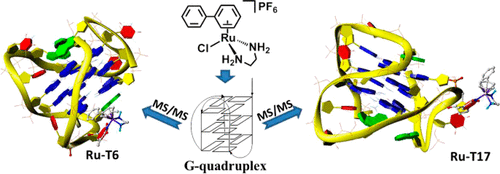当前位置:
X-MOL 学术
›
Organometallics
›
论文详情
Our official English website, www.x-mol.net, welcomes your feedback! (Note: you will need to create a separate account there.)
Tandem Mass Spectrometry Reveals Preferential Ruthenation of Thymines in Human Telomeric G-Quadruplex DNA by an Organometallic Ruthenium Anticancer Complex
Organometallics ( IF 2.8 ) Pub Date : 2020-09-18 , DOI: 10.1021/acs.organomet.0c00399 Chao Huang 1 , Ziqi Ma 1 , Jiafan Lin 1 , Xianxian Gong 1 , Fengfeng Zhang 1 , Xiaoqin Wu 1 , Fuyi Wang 2, 3 , Wei Zheng 4 , Yao Zhao 2 , Kui Wu 1
Organometallics ( IF 2.8 ) Pub Date : 2020-09-18 , DOI: 10.1021/acs.organomet.0c00399 Chao Huang 1 , Ziqi Ma 1 , Jiafan Lin 1 , Xianxian Gong 1 , Fengfeng Zhang 1 , Xiaoqin Wu 1 , Fuyi Wang 2, 3 , Wei Zheng 4 , Yao Zhao 2 , Kui Wu 1
Affiliation

|
The interaction of the organometallic ruthenium(II) anticancer complex [(η6-biphenyl)Ru(en)Cl][PF6] (1; en = ethylenediamine) and a 22-mer human telomeric G-quadruplex (G4) DNA (sequence 5′-A1GGGTTAGGGTTAGGGTTAGGG22-3′; I) was investigated by mass spectrometry analysis. Electrospray ionization mass spectrometry (ESI-MS) was first applied to probe the interaction of complex 1 with an equal molar ratio of human telomeric G-quadruplex DNA I (G4-I) under negative-ion mode. Tandem mass spectrometry using collision-induced dissociation (CID) was further introduced to identify the ruthenation sites. Primary mass spectrometric results showed that monoruthenated and diruthenated G4-I adducts were the main products under the given conditions. MS/MS results by the CID fragmentation of monoruthenated G4-I indicated that ruthenium complex 1 binds at T17 or T6 on G4-I. Further fragmentation of diruthenated G4-I confirmed preferential ruthenation at both T17 and T6, while no ruthenation at the guanine base was observed. This is the first report to identify the binding sites of organometallic ruthenium(II) anticancer complexes to human telomeric G-quadruplex DNA using tandem MS. Given the preferential binding of complex 1 at guanine bases of ssDNA and dsDNA, the preferential ruthenation of thymine over guanine in the G-rich human telomeric DNA implicates that thymines located in the flexible loops are more likely to be involved in interactions of the organometallic ruthenium anticancer complex with telomeric DNA when the guanine bases are engaged in the G-quartets of the G-quadruplex DNA.
中文翻译:

串联质谱揭示了有机金属钌抗癌复合物在人端粒G-四链体DNA中胸腺嘧啶的优选钌。
有机金属钌(II)抗癌剂络合物[(η的相互作用6 -联苯)的Ru(烯)CL] [PF 6 ](1和22-mer的人端粒G-四链体(G4)DNA(; EN =乙二胺)通过质谱分析研究了序列5′-A 1 GGGTTAGGGTTAGGGTTAGGG 22 -3′;I)。首先使用电喷雾电离质谱(ESI-MS)来检测配合物1与等摩尔比的人类端粒G-四链体DNA I(G4- I)在负离子模式下。进一步引入了使用碰撞诱导解离(CID)的串联质谱法来鉴定钌的位点。初步的质谱结果表明,在给定条件下,单钌和去硝基的G4- I加合物是主要产物。MS / MS的结果通过monoruthenated G4-的CID碎裂我指出,钌络合物1个结合在T 17或T 6上G4-予。脱氨基的G4- I进一步碎裂,证实在T 17和T 6上均优先钌化,而在鸟嘌呤基部未观察到钌。这是第一篇使用串联质谱法鉴定有机金属钌(II)抗癌复合物与人端粒G-四链体DNA结合位点的报告。鉴于复合物1在ssDNA和dsDNA的鸟嘌呤碱基上优先结合,在富含G的人类端粒DNA中,胸腺嘧啶比鸟嘌呤的优先钌化表明,位于柔性环中的胸腺嘧啶更可能参与有机金属钌的相互作用当鸟嘌呤碱基参与G四联体DNA的G四联体时,可与端粒DNA形成抗癌复合物。
更新日期:2020-09-28
中文翻译:

串联质谱揭示了有机金属钌抗癌复合物在人端粒G-四链体DNA中胸腺嘧啶的优选钌。
有机金属钌(II)抗癌剂络合物[(η的相互作用6 -联苯)的Ru(烯)CL] [PF 6 ](1和22-mer的人端粒G-四链体(G4)DNA(; EN =乙二胺)通过质谱分析研究了序列5′-A 1 GGGTTAGGGTTAGGGTTAGGG 22 -3′;I)。首先使用电喷雾电离质谱(ESI-MS)来检测配合物1与等摩尔比的人类端粒G-四链体DNA I(G4- I)在负离子模式下。进一步引入了使用碰撞诱导解离(CID)的串联质谱法来鉴定钌的位点。初步的质谱结果表明,在给定条件下,单钌和去硝基的G4- I加合物是主要产物。MS / MS的结果通过monoruthenated G4-的CID碎裂我指出,钌络合物1个结合在T 17或T 6上G4-予。脱氨基的G4- I进一步碎裂,证实在T 17和T 6上均优先钌化,而在鸟嘌呤基部未观察到钌。这是第一篇使用串联质谱法鉴定有机金属钌(II)抗癌复合物与人端粒G-四链体DNA结合位点的报告。鉴于复合物1在ssDNA和dsDNA的鸟嘌呤碱基上优先结合,在富含G的人类端粒DNA中,胸腺嘧啶比鸟嘌呤的优先钌化表明,位于柔性环中的胸腺嘧啶更可能参与有机金属钌的相互作用当鸟嘌呤碱基参与G四联体DNA的G四联体时,可与端粒DNA形成抗癌复合物。


























 京公网安备 11010802027423号
京公网安备 11010802027423号